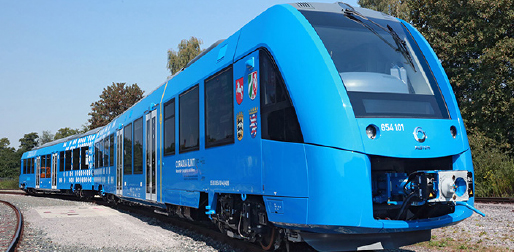
World first hydrogen-powered and zero-emission passenger Train

World first hydrogen-powered and zero-emission passenger Train
World first hydrogen-powered and zero-emission passenger train named as Coradia iLint was unveiled in Germany. The first of its kind ecofriendly train has been developed by French rail company Alstom.
The Coradia iLint only emits excess steam and condensed water into the atmosphere. Key Facts Coradia iLint is powered by a hydrogen fuel tank fitted on its roof. The fuel cell is supplied with hydrogen and oxygen from the air. The fuel cell converts hydrogen and oxygen into electric power.
Excess electric is stored with onboard lithium batteries. The train is totally carbon-neutral and carbon-free which makes it a much more sustainable alternative conventional diesel trains. Besides, the claims speeds of up to 87 miles per hour and has a hydrogen storage capacity for a 497-mile range. Way forward The testing of the hydrogen-powered train will be carried out by the end of 2016 in Germany.
If the results prove successful, the trains will service the Buxtehude-Bremervörde-Bremerhaven-Cuxhaven line in Lower Saxony, Germany by December 2017.
Coradia iLint regional train
Coradia iLint is an advanced full emission-free train solution for passenger rail transportation. It is based on Alstom’s successful Coradia Lint regional platform. The traction system of Coradia iLint is using fuel cells which produce electricity by combining hydrogen and oxygen to water.
A full emission-free train
Alstom offers a unique and sustainable alternative to non-electrified network operators: the emission-free regional train Coradia iLint. Alstom is the first rail manufacturer worldwide to develop a low floor passenger train powered by a hydrogen fuel cell.
A combination of innovations
Coradia iLint is special for its combination of different innovative elements: a clean energy conversion, a flexible energy storage and smart management of the traction power and remaining energy. The principle relies on a fuel cell which produces the electric power. The fuel cell is supplied with hydrogen on demand. Coradia iLint is developed in partnership with renowned German and Canadian companies boasting many years of experience in the fields of hydrogen energy and batteries.
Equal performances
Coradia iLint is based on the service proven of the diesel train Coradia Lint. Replacing the diesel traction by the fuel cell technology enables sustainable train operation while its performance matches that of regular regional trains. It can run at 140 km/h, with a 600 to 800 km/tankful autonomy, and accommodate up to 300 passengers.
A global approach
Alstom provides a complete offer consisting of the train itself, its maintenance but also the whole hydrogen infrastructure out of one hand. This
comprehensive solution allows operators to better focus on their core business.
The Company
ALSTOM As a promoter of sustainable mobility, Alstom develops and markets systems, equipment and services for the railway sector.
Today entirely refocused on rail transport, Alstom manages the widest range of solutions in the market-from high-speed trains to metros and
tramways-customised services (maintenance, modernization, etc.), infrastructure and signalling solutions.
Alstom, a world leader in integrated railway systems. It recorded sales of ˆ6.9 billion and booked ˆ10.6 billion of orders in the 2015/16 fiscal year.
Headquartered in France, Alstom is present in over 60 countries and employs 31,000 people today.








